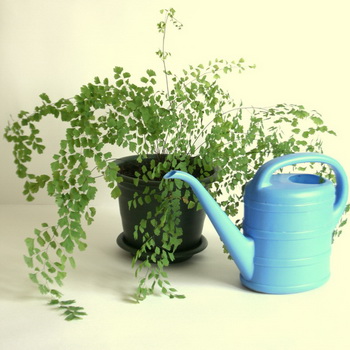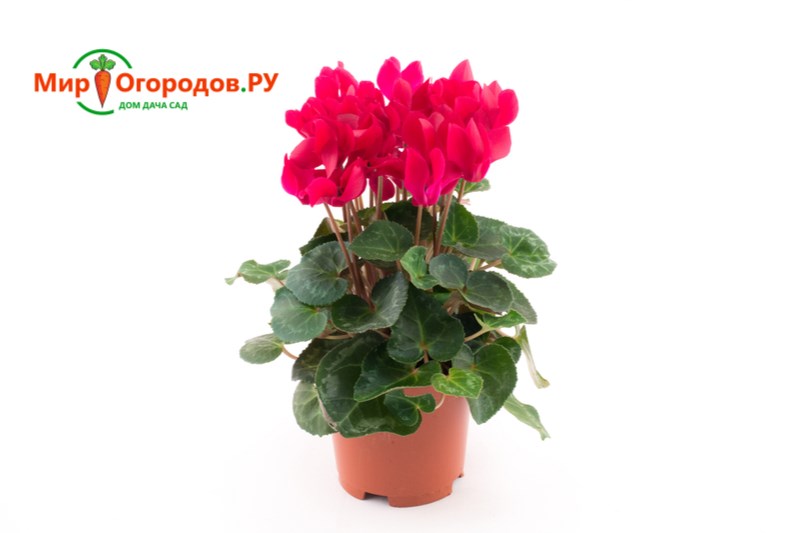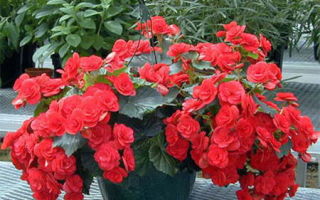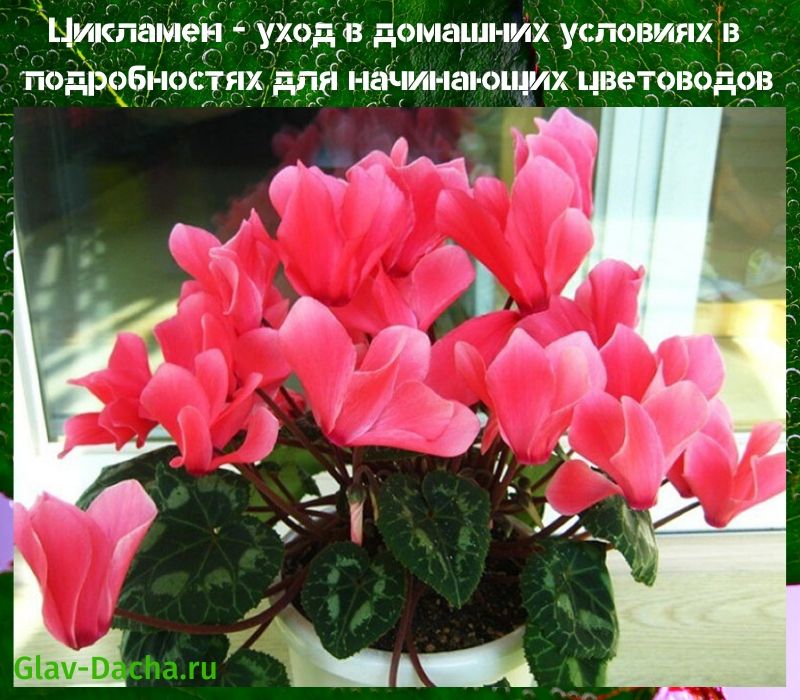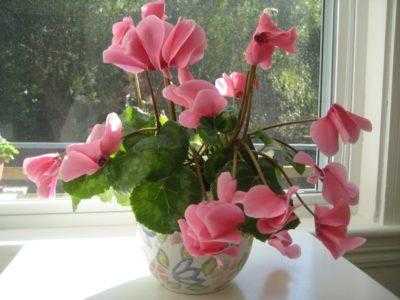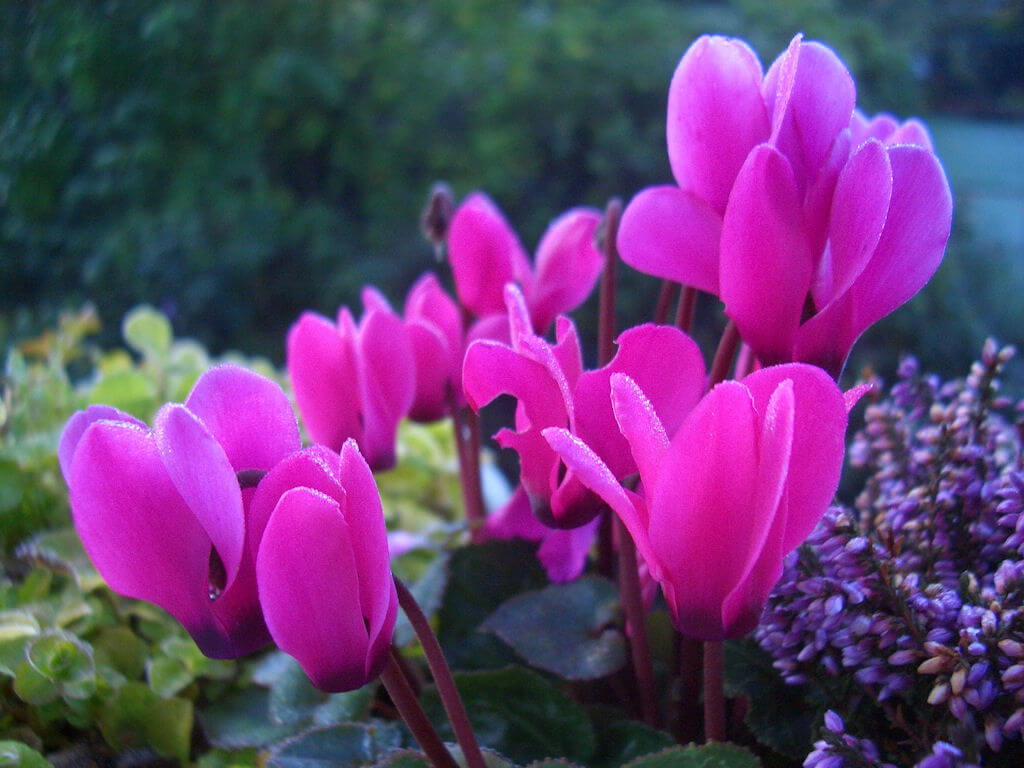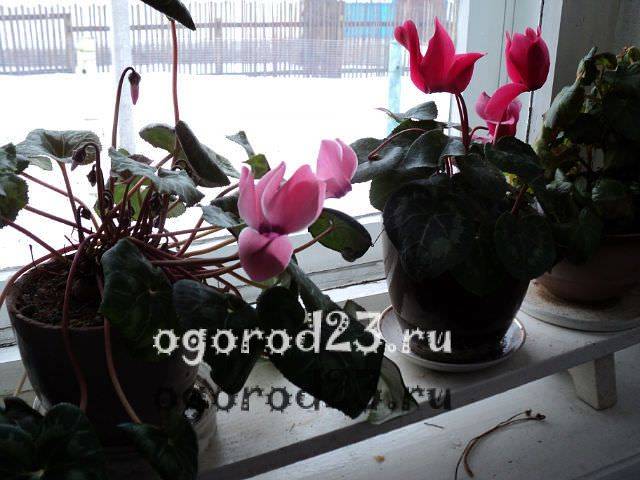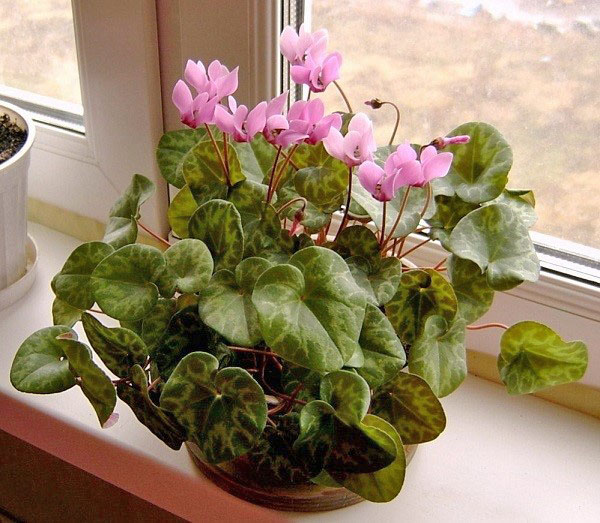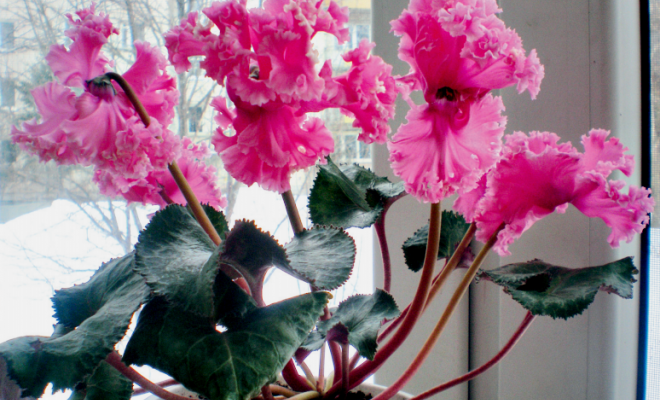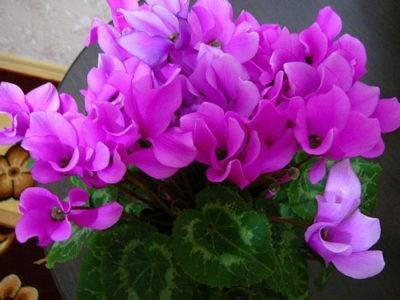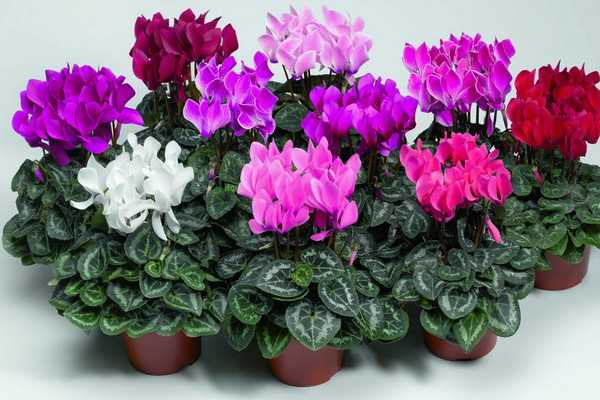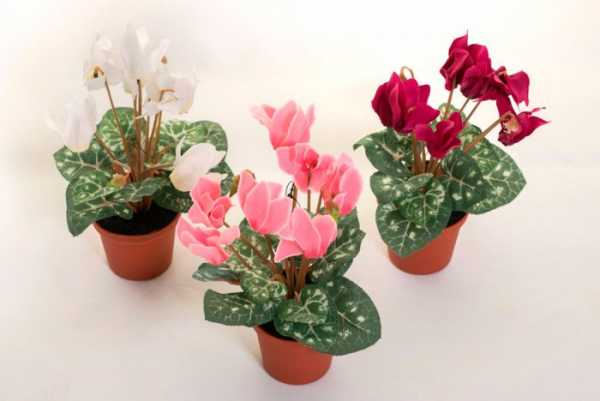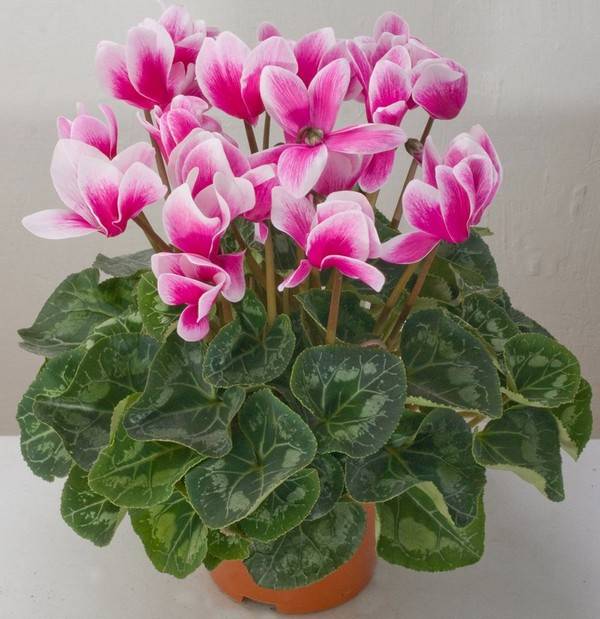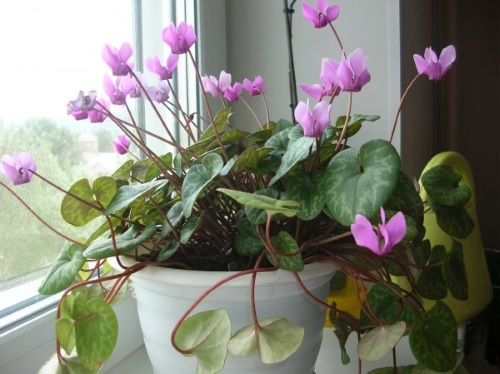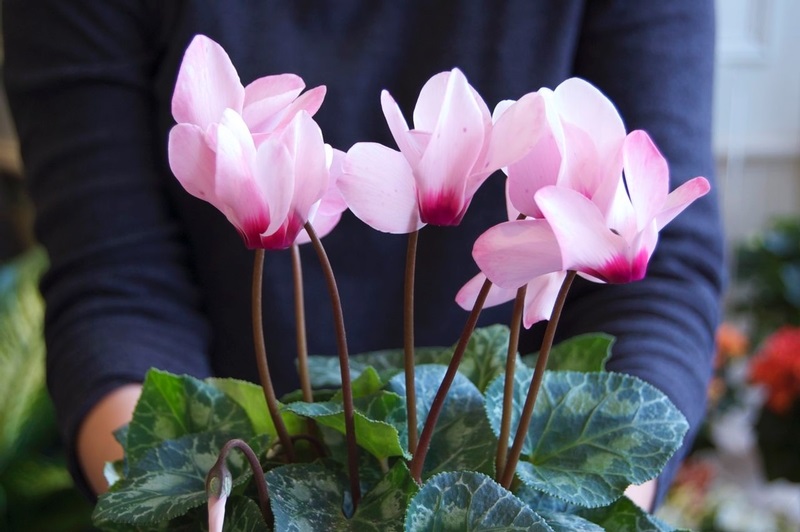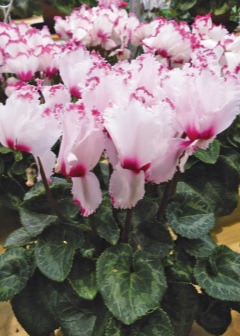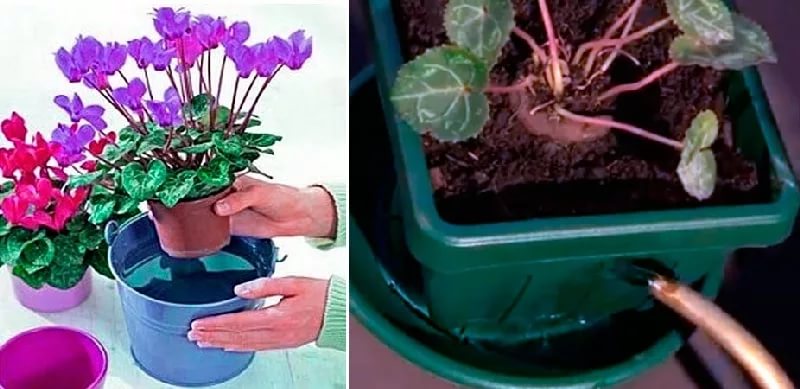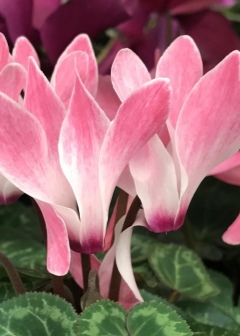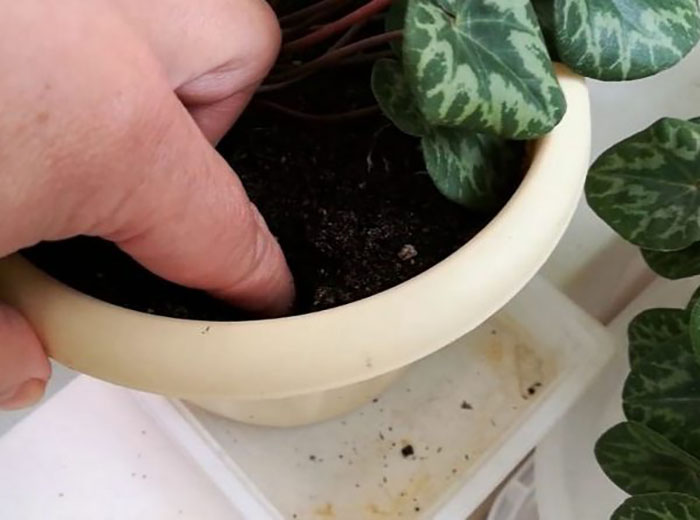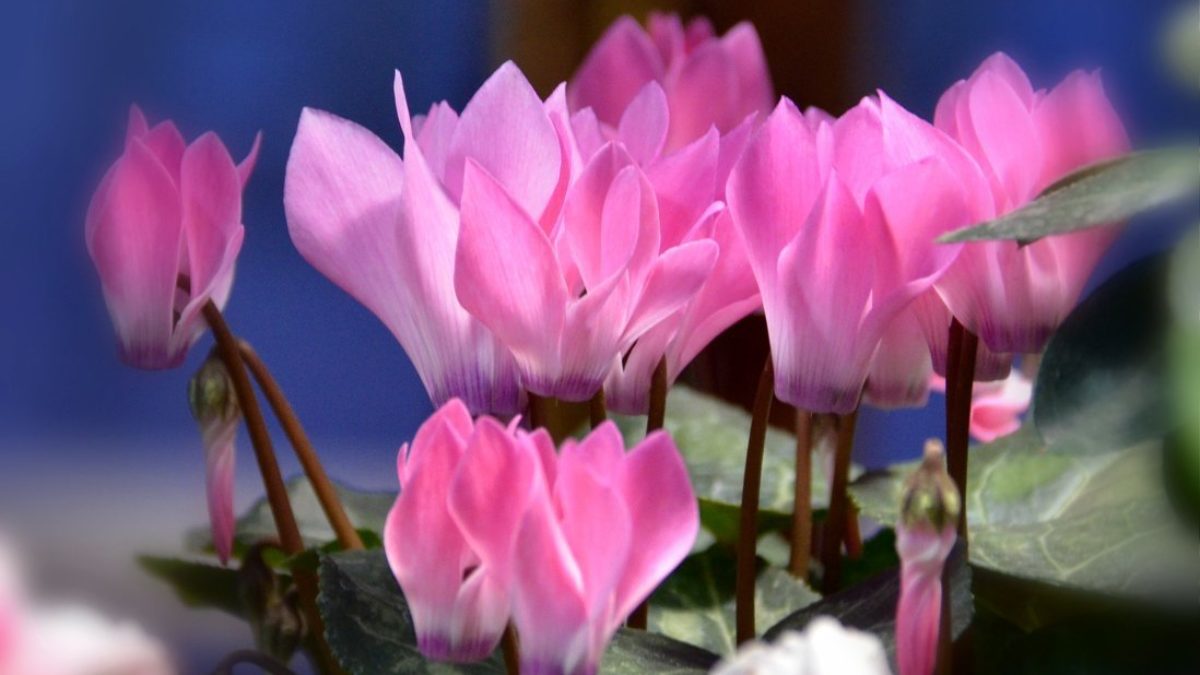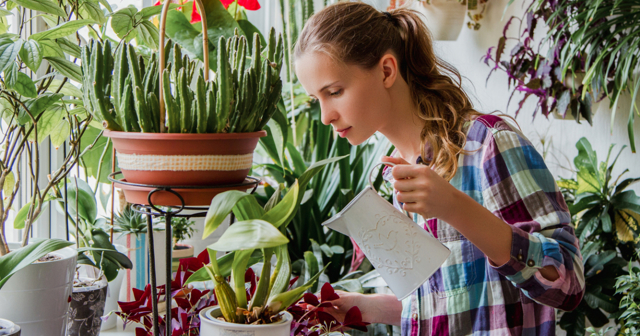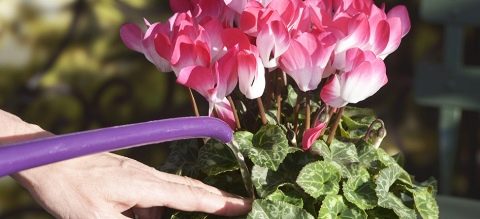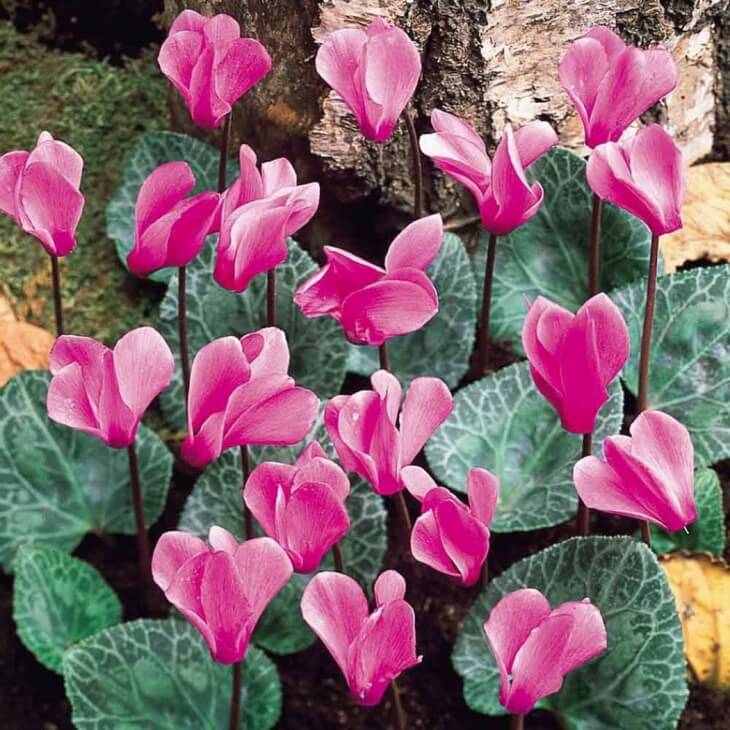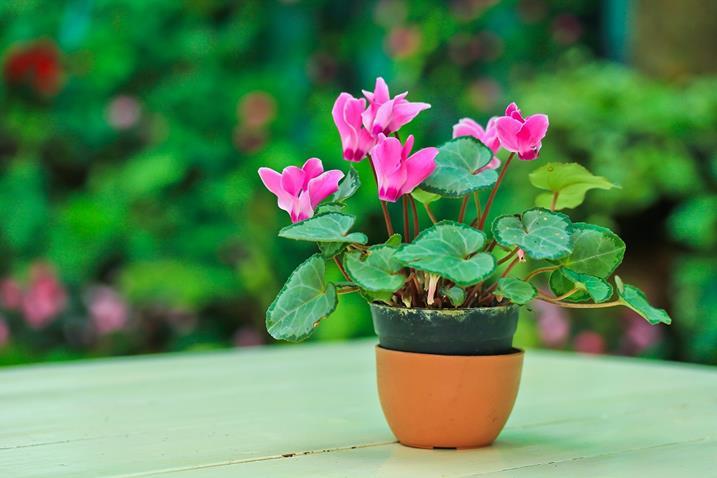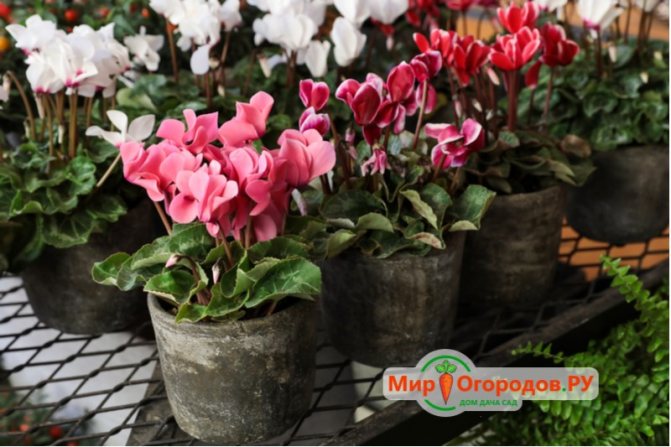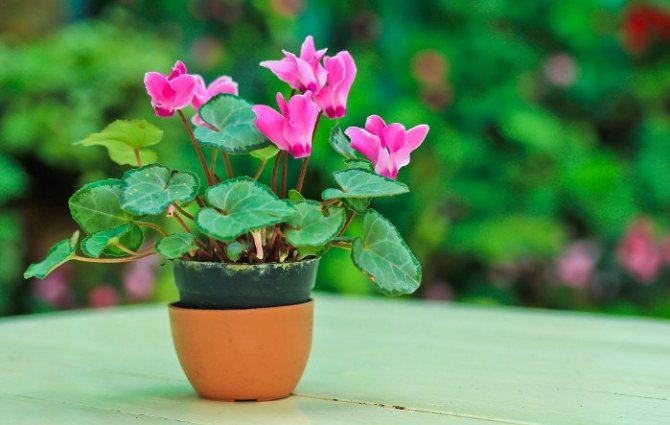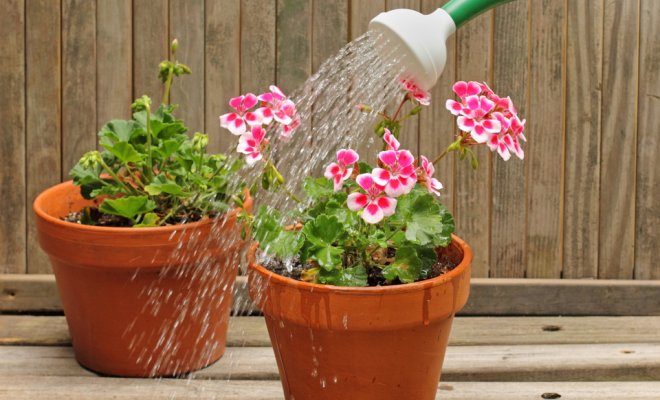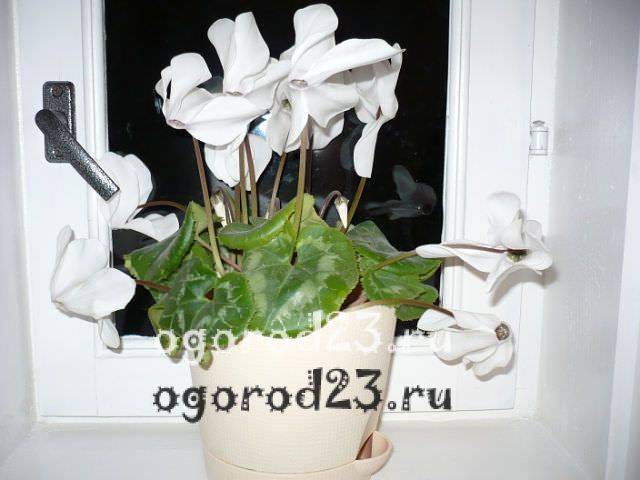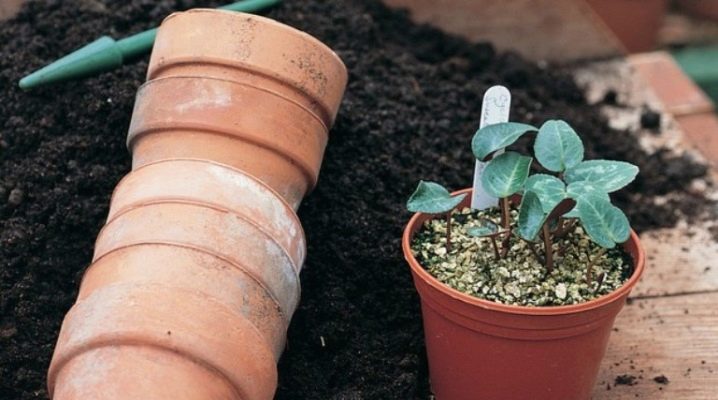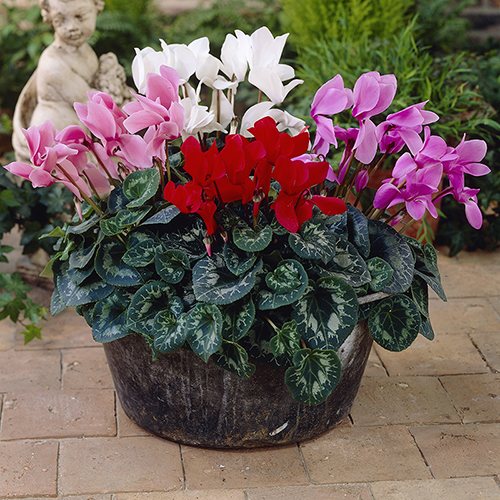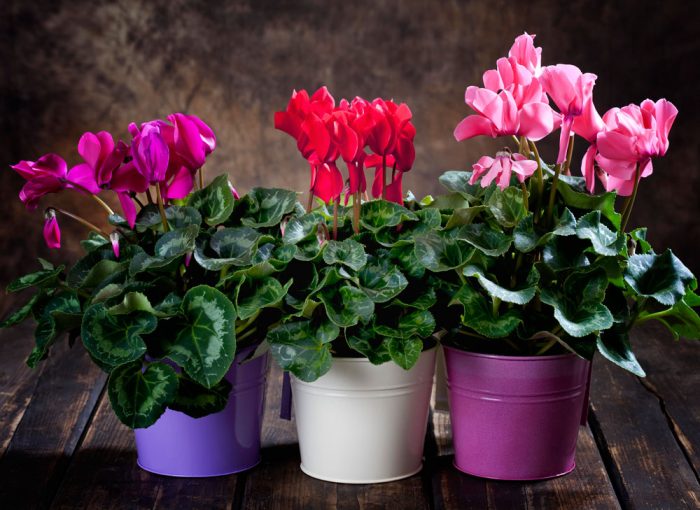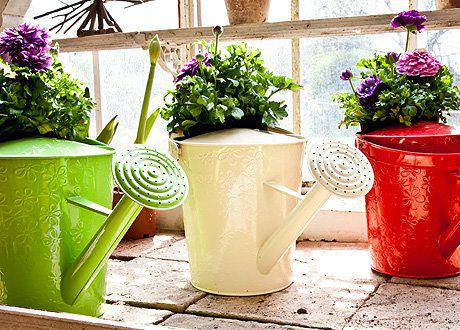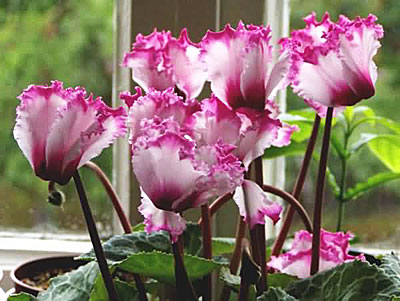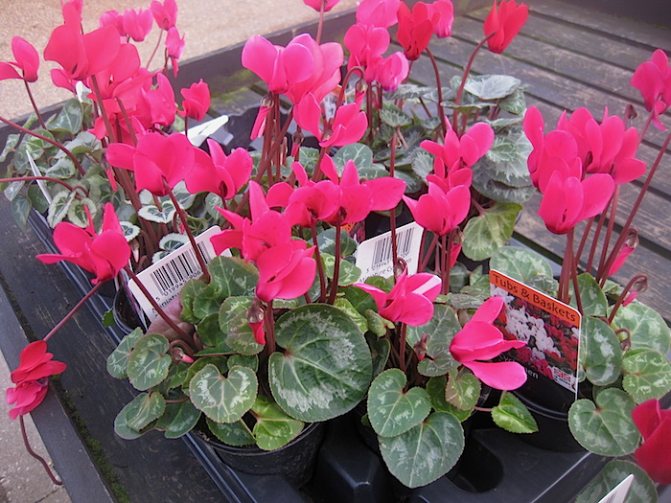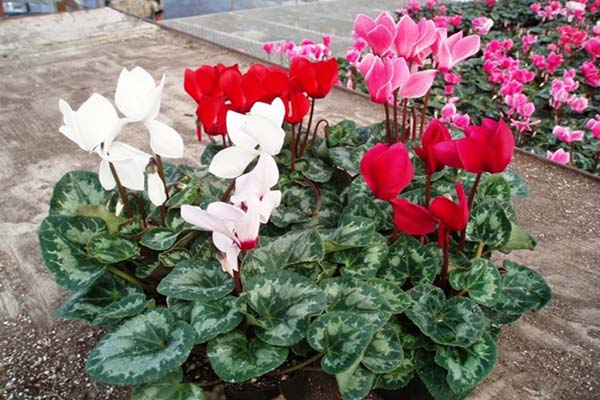How to water a flower in winter?
Watch the cyclamen at rest. When you notice that the bush has begun to release new leaves and buds, gradually increase the amount of watering fluid and reduce the intervals between dampening. Do not abruptly change the mode of care, the plant can rot from the abundance of moisture. The frequency of watering depends on the age of the flower. Young bushes have weak roots, they need to be watered often, but not very abundantly. In a three-year-old cyclamen, a strong tuber is able to create good reserves of water and nutrients, it can be moistened less often, and the volume of water should be greater. You also need to consider the following conditions:
- room temperature;
- air humidity;
- lighting (in the light, the flower needs more water than in the twilight).
For watering, you need to take soft clean water at room temperature. It would be nice to use a key, thawed or rainwater. During the flowering period, watering can be combined with fertilizing with fertilizer for violets. The flower responds very well to watering with water with phytohormones. But do not overfeed your pet, otherwise it will release lush greenery to the detriment of flowering. Read the instructions, it should say how often to use and in what proportions to dilute the drug. Usually, feeding is recommended to be carried out no more than once a month.
Water the cyclamen as soon as the topsoil dries. Drops of moisture have a detrimental effect on the leaves and flowers of the plant.
- It is most convenient to use a small watering can, with the spout of which you can gently moisten the soil along the walls of the pot. If you have not overdried the flower, moisture will quickly spread throughout the entire volume of the earthy coma. With this method, the tuber will also not be affected by moisture. After an hour, drain the liquid from the trays.
- You can water the cyclamen by immersing the pot in liquid. If tap water is used for this purpose, it must stand for at least a day. Fill a basin and place a pot in it so that the liquid does not reach a little to the edges of the container. When a wet shine appears on the surface of the soil, indicating that the water has soaked all the soil, you need to remove the flower and let the excess moisture escape through the drainage holes.
Throughout the winter, the cyclamen delighted you with bright inflorescences, and in May it became sad: the leaves turned yellow, the buds are not visible. It means that the flower is tired, it is time for him to rest. Place the pot in a cool place and switch to summer watering. Do not worry, in the warm season, many plants will delight you with lush inflorescences, and let the cyclamen rest. In the winter cold, he will again release numerous buds and decorate the room with an abundance of flowers. Do not disturb your pet, let the plant rest and gain strength before the new flowering season.
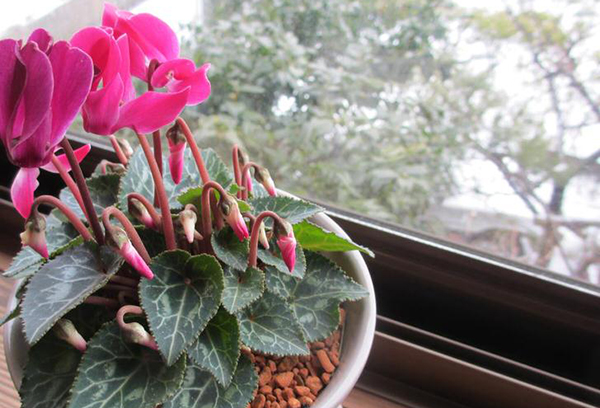
Why cyclamen does not bloom - care errors
The complete absence of flowering or its scarcity is most often associated with improper plant care.
Incorrect temperature setting
The ideal temperature for flowering cyclamen is 15-18 ° C. Some varieties require a lower temperature - from +10 ° C. At elevated temperatures, the stems of the leaves begin to stretch, which negatively affects the well-being of the plant.
Note! Dropped leaves are a sign of a depressed state of cyclamen. A pot with cyclamen has no place on the windowsill above hot radiators
It is placed on a glazed balcony or between frames
The cyclamen pot has no place on the windowsill above the hot radiators. It is placed on a glazed balcony or between frames.
Watering errors
Water for irrigation must be defended.During irrigation, moisture should not get on the leaves or tuber. During flowering, the soil is constantly kept moist, but without waterlogging.
Important! To avoid mistakes when watering, water is poured into a sump, and the roots themselves regulate the desired moisture level. To do this, a drainage layer is created at the bottom of the container.

Watering with settled water
Incorrect planting or transplanting a plant
You can find out the reason for the lack of flowering of cyclamen by carefully examining the planted tuber in a pot. If it is completely buried in the ground, then flowering cannot be expected. The tuber should protrude from the ground by a third.
Additional Information. The size of the container when transplanting is selected according to the rule: the edge of the pot should be only 2-3 cm higher than the top of the tuber.
The reason for the lack of flowering may be a tuber affected by infectious diseases.
Incorrectly selected soil will prevent the cyclamen from fully blooming
First of all, attention is paid to its acidity, the level of which should be pH 5.5-6.5
Insufficient nutrients
With a lack of nutrition, the plant may not bloom at all. The leaves are the first to react to the lack of feeding. They shrink, turn yellow, curl.

Cyclamen is not getting enough nutrition
If the buds have time to form, and fertilizers have ceased to flow sufficiently, the inflorescences begin to fall off.
Important! The imbalance of mineral elements is eliminated gradually, the plant does not tolerate the application of fertilizers with “shock” doses. When self-growing cyclamen from seed, the sprouts are supported with a growth activator
When self-growing cyclamen from seed, the sprouts are supported with a growth activator.
It is possible to explain why cyclamen does not bloom, but only leaves grow, when analyzing the composition of dressings. Fertilizers with nitrogen cause vigorous growth of leaves to the detriment of flowering. An overdose of nitrogen can provoke rotting of the tuber.
Basic watering methods
Above
The most popular method of watering from above for violets is not very suitable for flower growers. It can be used when the flower is still young and has few leaves.
Water from a watering can or from a plastic bottle is carefully poured into the soil, making sure that it does not get into the center of the flower and does not moisten the leaves.
Wetting the leaves can be especially detrimental to adult plants. Wet leaves in a draft or under the influence of the sun are damaged and burned, which can result in the death of the plant.
Drip irrigation
 Drip irrigation can be an alternative. A container with water is fixed above the plant. For example, a regular plastic bottle.
Drip irrigation can be an alternative. A container with water is fixed above the plant. For example, a regular plastic bottle.
A silicone hose is inserted into the bottle. The other end of the hose is placed in the root area of the violet.
The dropper system, which can be purchased at any pharmacy, is excellent for these purposes.
From one container, thanks to hose connectors and splitters, it is possible to organize the feeding of several violets.
The water supply is regulated so that it does not flow, but drips under the root of the plant. In this case, the distribution of moisture occurs evenly. Excess moisture in the presence of control over the system is excluded.
In the absence of a drip system, you can use a conventional medical syringe or medical bulb. Water should be fed gently between the leaves in thin streams.
With pallets
If the plant is already mature with large leaves, the best way to water it is by watering in trays.
At the same time, water is poured into a pan under the pot and left for 30 minutes. This is enough for the flower to take as much moisture as it needs. At the end of the process, the water is poured out. Excess moisture in the lower areas can cause root rot on the violet.
Through immersion
An alternative to pallet watering is the immersion method. A pot with a flower is placed in a container that is filled with warm water 36-40 ° C to two-thirds of the height of the pot. After the soil has darkened, the pot is removed from the water.
A variety of immersion watering is considered to be Texas watering. At the same time, holes with a diameter of 3-4 mm are drilled at a height of 5 cm from the bottom of the pot. The space below the holes is filled with drainage. Usually, expanded clay pebbles of different sizes play the role of drainage.
A substrate is placed on the drainage layer, in which a violet is planted. The flower pot is submerged in water. The water level should not reach the side holes - they are only for oxygen supply to the roots. After the soil darkens, the pot is removed from the water.
Wick watering - how to make and use
 Wick watering is considered to be the best way to supply moisture to the roots of violets growing in small containers.
Wick watering is considered to be the best way to supply moisture to the roots of violets growing in small containers.
When transplanting, a cord made of synthetic materials is laid at the bottom of the pot. Normal boots will do.
Natural materials will not work, since synthetics are more resistant to the aquatic environment. From above it is covered with soil, where the flower fights.
The other end of the lace is lowered into the water. In this case, the flower should be located above the liquid level. The liquid should not touch the bottom of the pot.
For the organization of wick irrigation, plastic cups are perfect, into which a flower pot is inserted. Water through the wick will flow in the required amount to the roots of the plant.
Important. In winter, this method should be used with caution, as the water quickly cools down under the influence of low temperatures.
This is especially true if violets grow on the windowsill.
Very cold water has a detrimental effect on the root system of the plant - growth may slow down sharply, inflorescences the next year may not appear at all.
Cyclamen care at home
Illumination
In order for the cyclamen to grow and develop fully, it needs proper lighting. A western or eastern window sill is best suited for this flower. Since the direct rays of the sun can harm the plant, if you have to put it on the southern windowsill, choose a place for it away from the window or shade it. The northern window is not suitable for a flower, as there is very poor lighting.
Temperature regime
In winter, normal development and lush flowering of cyclamen is possible only if the air temperature is within 10-14 degrees. In the warm season, the optimum temperature for such a plant is 20-25 degrees.
Watering
Water the flower with soft water, the temperature of which is 2 degrees below room temperature. It is collected in a container 24 hours before watering and allowed to settle well. Watering should be abundant throughout the flowering period. Do not overdry the substrate in the pot, and also make sure that no liquid stagnates in it. For cyclamen, bottom watering (through a sump) is well suited, in this case water will not get on the tuber, core and buds of the bush. When the plant is watered, after 2-3 hours, be sure to pour excess water from the pan. At the end of flowering, watering is reduced, and when all the foliage is completely dry, and the tuber is also exposed, watering should become very scarce and rare.
Air humidity
In order to increase the humidity of the air, the bush is moistened from a spray bottle, using rain or well-settled water for this. However, a similar procedure can be carried out only before the formation of buds, and after that, to increase the humidity level, another method is used: wet peat or pebbles are poured into the pallet and a flower pot is placed on it. Make sure that the bottom of the container does not come into contact with water.
Fertilizer
You need to start feeding the flower from the moment the leaves appear, for this they use a complete mineral or organic fertilizer. As soon as flowering begins, all feeding is stopped. Remember that if there is too much nitrogen in the substrate, then this can lead to the appearance of rot on the tuber.
Dormant period
As soon as the foliage begins to dry out and die off the flower, this indicates that a period of dormancy begins. Reduce the frequency, as well as the abundance of watering, and this should be done gradually. And when the plant is completely bare, it is watered sparsely and infrequently.
The room where the plant is located is systematically ventilated. If possible, transfer it to a balcony that is shaded from the sun. In August or September, the bush is transferred to a well-lit place and begins to gradually increase watering. During the dormant period, the flower at home can be stored in another way: when the bush fades, watering is reduced, and when all the foliage dies off, the pot should be turned 90 degrees and in this position it will be stored until the last summer or first autumn weeks ...
Bloom
Home-grown cyclamen is capable of blooming magnificently for up to fifteen years in a row, while annually up to 70 spectacular flowers will form on it. After the flowers wither, they, together with the peduncle, are carefully pinched off near the tuber, it is highly undesirable to cut them off. Then the rupture site is treated with powdered charcoal.
Cyclamen transplant
The transplant is carried out annually in August or September, and this is done after the first foliage appears from the tuber. Choose a wide container for transplanting, and fill it with a loose substrate with a pH of 5.5–6. The approximate composition of the soil mixture: humus, sand and peat (one part at a time), and also leafy soil (2 or 3 parts). You can also use a substrate of the following composition: sand, humus and leafy soil (1: 2: 4). If the pH of the soil mixture is higher than 6.5, then the likelihood that the plant will be affected by fungal diseases increases.
After the bush is removed from the pot, cut off all rotten roots, while trying not to injure healthy ones. When planting a tuber, keep in mind that it should rise by half or a third above the soil mixture, thanks to this, the flowering of the cyclamen will be more magnificent. To avoid stagnation of water in the root system, do not forget to make a good drainage layer at the bottom of the container.
How to properly transplant cyclamen at home
Virulence
In the juice of any part of the Persian cyclamen bush, as well as its tuber, there are poisonous substances that can cause diarrhea, convulsions and vomiting.
How is cyclamen useful?
An infusion is prepared from cyclamen, which is used for colic, rheumatism, neuralgia, indigestion and flatulence.
Peculiarities
Any plant needs regular soil moisture. As a rule, owners of home flowers water them only when the ground becomes completely dry. But this approach is not entirely correct
After all, it is important to take into account not only the degree of dryness of the soil, but also the characteristics of the root system of a particular plant.
It is also important to take into account what time of the year outside the window, for example, in the summer the flower needs more frequent watering than in the winter. Proper care and timely watering is the key to the health and beauty of your favorite plant.
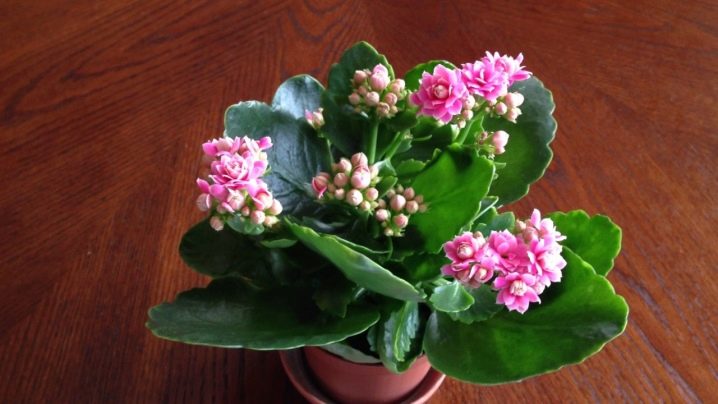
Watering a plant like Kalanchoe too often is not worth it. In case of excessive moisture, the roots of this plant will begin to rot a little, which ultimately will lead to the death of the Kalanchoe. Excessive moisture, especially during the cold season, can lead to the plant simply disappearing.
In addition, improper watering can cause other problems, for example, various fungal diseases can begin. This is especially dangerous during the flowering of a house plant, since the fungus will adversely affect the formation and development of the bud itself.

In the event that the plant does not have enough moisture, this will also negatively affect its condition. The leaves will begin to wither, dry out, turn yellow and fall off.
In the hot season: in spring and summer, this type of plant especially needs proper and regular watering.During this period, it is advisable to water the Kalanchoe at least twice a week. Especially if the container with a flower is on the sunny side.

It is worth mentioning separately that the Kalanchoe should be watered not only with ordinary water, but also with water with the addition of various kinds of dressings. This will allow the root system to be saturated with useful substances, which will have a beneficial effect on the general condition of the flower.
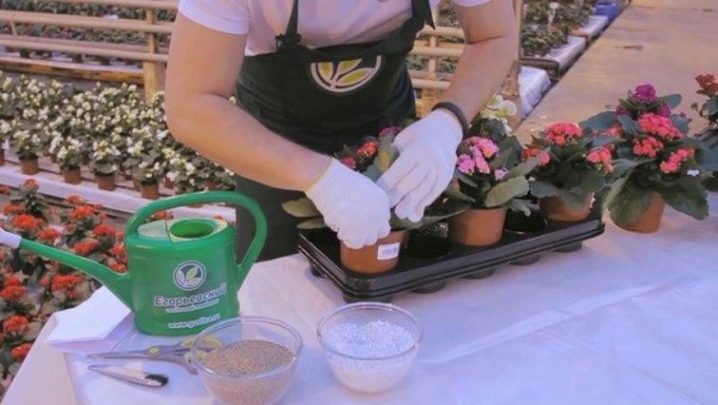
In autumn and winter, you should switch to a different watering regime, since in the cold season, excessive watering and spraying of the plant can lead to its death. As a rule, on cold days the Kalanchoe should be watered every two weeks.
Since the flowering period for this type of plant usually begins at the end of winter, it will need to be watered once a week. In this case, it is necessary to alternate watering with ordinary water with watering with liquid with useful additives.
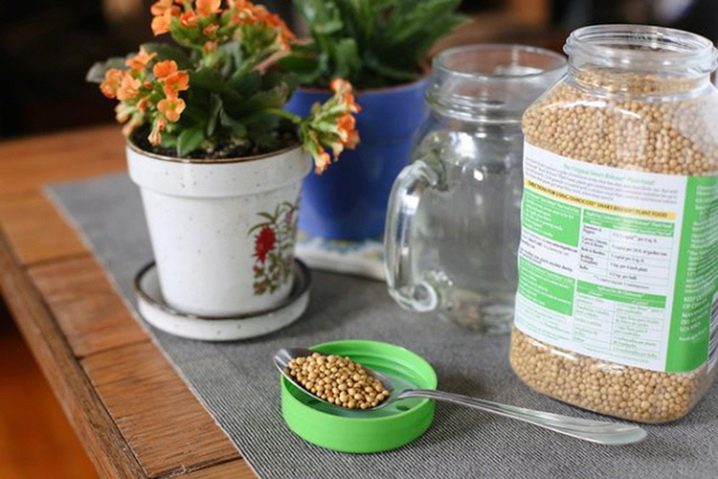
The main rules of watering
There are several simple rules for watering a plant at home. If you follow all the recommendations on how to water the Kalanchoe at home, you can guarantee the health of the culture. This is the only way you can grow a strong and beautiful bush. What are the main rules for watering? How to water Kalanchoe at home?

For watering, it is necessary to use only boiled or previously settled water. In addition, there must be no sediment in the liquid. Thanks to this, calcium and magnesium salts do not get into the soil. Therefore, before watering the Kalanchoe, be sure to prepare the water.
The temperature of the liquid should be at room temperature. The fact is that cold water can cause rotting of the root system, as well as the development of other unpleasant diseases. This is one of the basic rules for how to water the Kalanchoe.
During the irrigation process, it is necessary to ensure that no liquid gets on the trunk, as well as on the rest of the crop. The fact is that for this reason, ugly brown spots and rot can form on the plant.
Speaking about how to properly water the Kalanchoe at home, you should also pay attention to the fact that it is necessary to monitor the moisture content of the soil, while preventing it from drying out and waterlogging. Therefore, a small amount of water is taken for irrigation.
30 minutes after watering the soil, all excess liquid that remains in the pan must be removed.
It is imperative to place a layer of expanded clay on the bottom of the pot with the plant, which will serve as a drainage. Thanks to this, all excess moisture will go away.
How often to water Kalanchoe at home? Watering frequency will depend on soil conditions. A sign of a lack of moisture is drying, falling leaves. In this case, watering should be regular, but very moderate. Yellowing and a long absence of flowering, as well as decay of foliage, indicates an excess of moisture in the soil. This situation can be corrected by completely replanting the plant, replacing the earthen lump. Thus, considering how often to water the Kalanchoe, will largely depend on the condition of the soil. Monitor its moisture regularly.
When to transplant cyclamen
The plant can be transplanted after the flowers have fallen and before the next buds begin to form. An annual transplant is needed to renew the flower and stimulate the growing season.
Transplanting indoor plants, how to properly transplant an indoor flower
The vegetative year of the flower should be divided into a period of rest and flowering. During hibernation, fertilizers are not applied, watering is minimal, the air temperature in the room is increased. This is a good time to transplant a plant as it is the least stressed.
If, under the right conditions, the bush does not bloom for a long time and begins to dry out, and the leaves turn yellow, you need to check it for pests. The aerial part is carefully examined.If the sheets are clean, check the condition of the roots. The tuber can be affected by rot or insects. In this case, an insecticide treatment is carried out, the damaged roots are removed, the tuber is transplanted into a new pot. Florists recommend in this case to completely replace the soil.
An adult plant may not fit in an old container. You should pull out the root and see how much space it takes up in the pot. If there is no room left for the development of the tuber, transplantation into a new, more spacious flowerpot is required.
Is it possible to transplant a flowering plant
It is not recommended to transplant any culture during the flowering period. The plant gives a lot of energy to the formation of buds, the opening of flowers, the formation of seeds. Transplanting a flowering cyclamen will lead to the fact that the buds dry out, the flowers fall off, the adaptation process will drag on. The subsequent flowering will have to wait for a long time.
There are cases when it is necessary to transplant cyclamen during the flowering period. These are bushes that are forcibly driven out for sale in a blooming state. When buying, the bush inevitably dies after the petals fall. But he can be saved in time. In such cases, an emergency transplant of a flowering cyclamen is made.
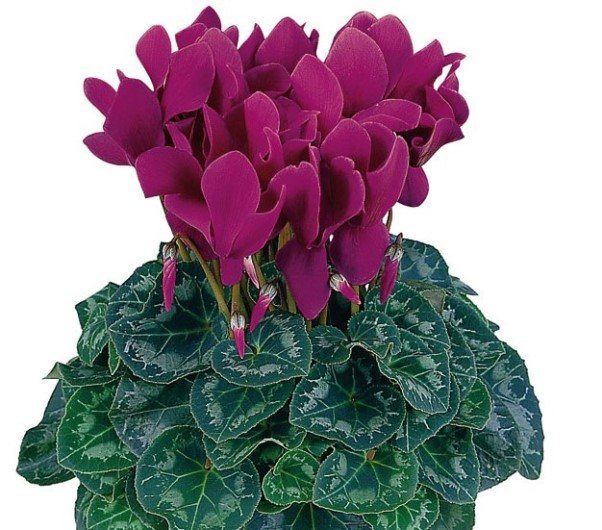
First of all, all the buds and flowers are cut off, the bush is transplanted into a new land. The substrate should not be fertilized. It is best to plant the flower in depleted soil, you can add more sand. The culture is introduced into a state of dormancy, transferred to a cold place, watered little and not fed.
How to transplant cyclamen at home is described step by step in the next section.
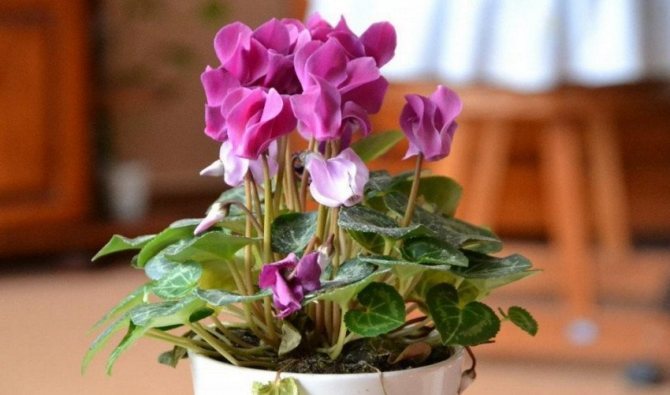
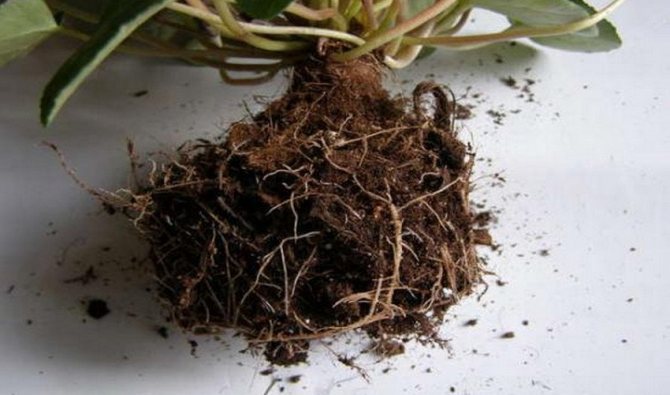

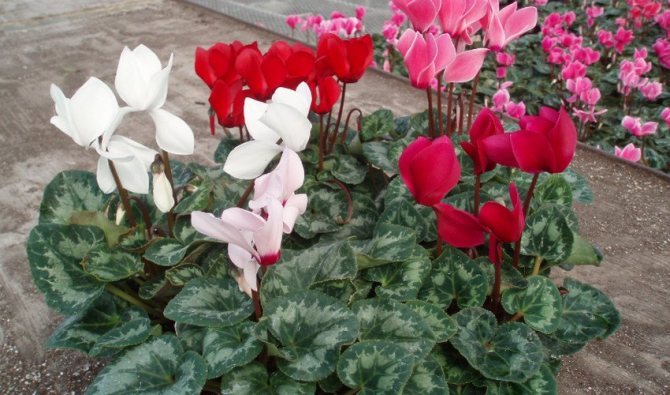
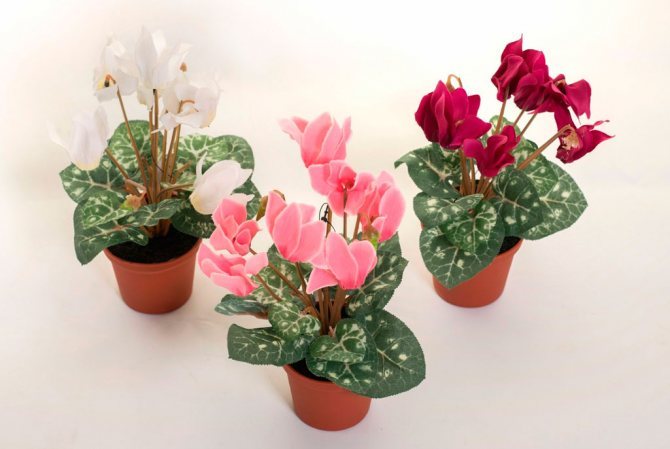
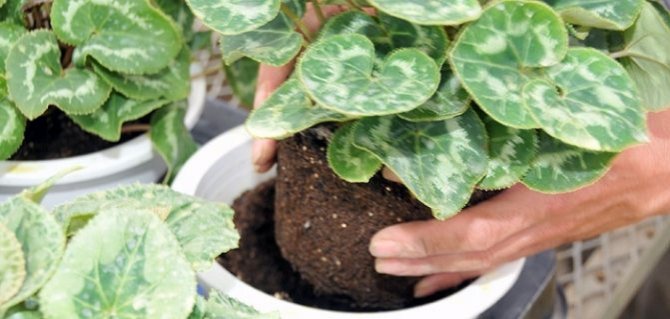
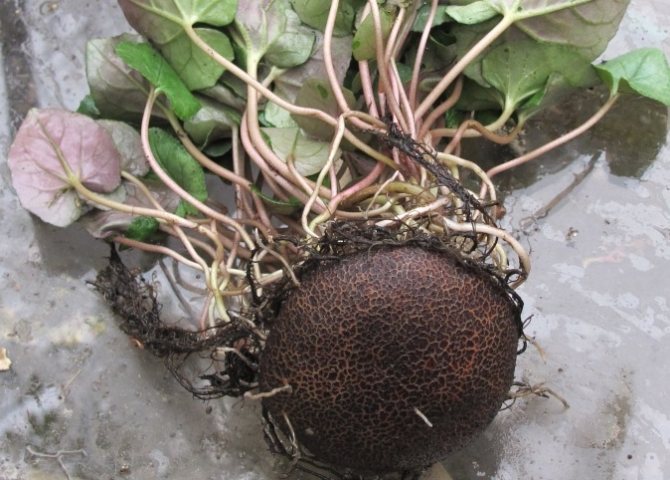
Cyclamen care at home
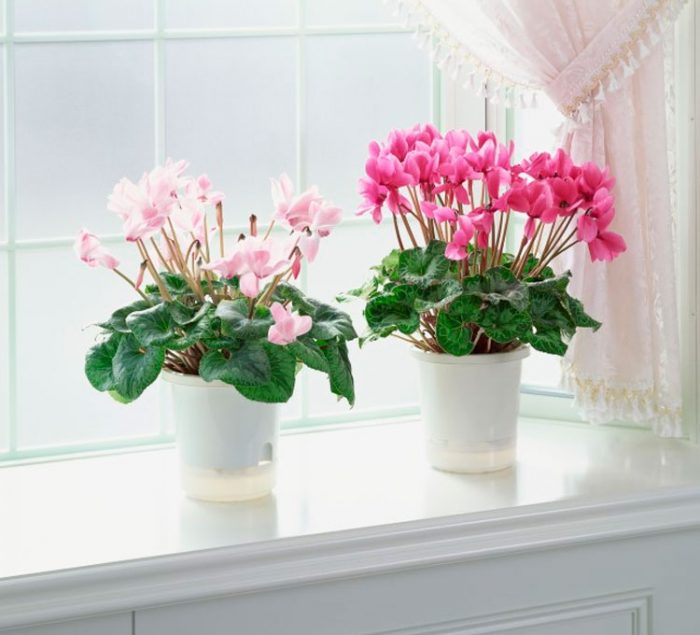
Illumination
In order for the cyclamen to grow and develop fully, it needs proper lighting. A western or eastern window sill is best suited for this flower. Since the direct rays of the sun can harm the plant, if you have to put it on the southern windowsill, choose a place for it away from the window or shade it. The northern window is not suitable for a flower, as there is very poor lighting.
Temperature regime
In winter, normal development and lush flowering of cyclamen is possible only if the air temperature is within 10-14 degrees. In the warm season, the optimum temperature for such a plant is 20-25 degrees.
Watering
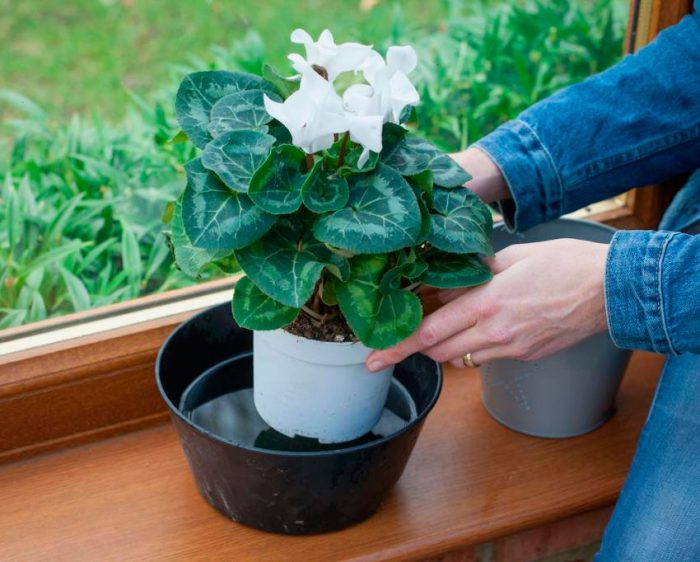
Water the flower with soft water, the temperature of which is 2 degrees below room temperature. It is collected in a container 24 hours before watering and allowed to settle well. Watering should be abundant throughout the flowering period. Do not overdry the substrate in the pot, and also make sure that no liquid stagnates in it. For cyclamen, bottom watering (through a sump) is well suited, in this case water will not get on the tuber, core and buds of the bush. When the plant is watered, after 2-3 hours, be sure to pour excess water from the pan. At the end of flowering, watering is reduced, and when all the foliage is completely dry, and the tuber is also exposed, watering should become very scarce and rare.
Air humidity
In order to increase the humidity of the air, the bush is moistened from a spray bottle, using rain or well-settled water for this. However, a similar procedure can be carried out only before the formation of buds, and after that, to increase the humidity level, another method is used: wet peat or pebbles are poured into the pallet and a flower pot is placed on it. Make sure that the bottom of the container does not come into contact with water.
Top dressing
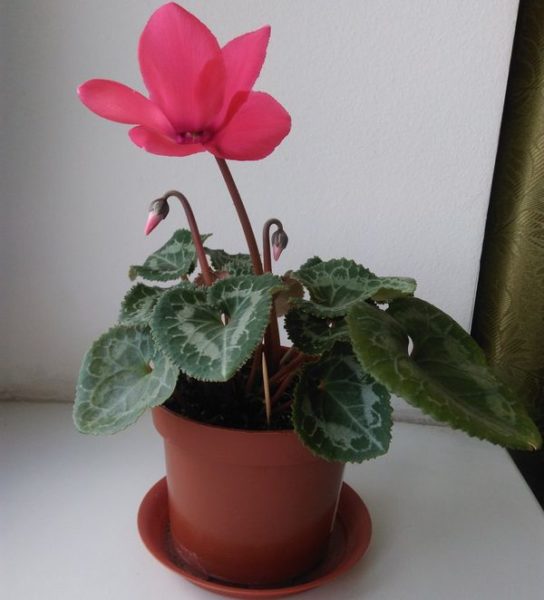
Features of feeding cyclamens:
- the frequency of fertilization is 1 time in 2–4 weeks;
- it is recommended to use fertilizers with a moderate nitrogen content;
- if the leaves turn yellow, it is necessary to apply an iron-containing fertilizer - by watering or spraying;
- feeding is stopped in April - the plant begins to prepare for a dormant period.
Excess nitrogen leads to leaf build-up and negatively affects the quantity and quality of buds.
Bloom

Home-grown cyclamen is capable of blooming magnificently for up to fifteen years in a row, while annually up to 70 spectacular flowers will form on it. After the flowers wither, they, together with the peduncle, are carefully pinched off near the tuber, it is highly undesirable to cut them off. Then the rupture site is treated with powdered charcoal.
Dormant period
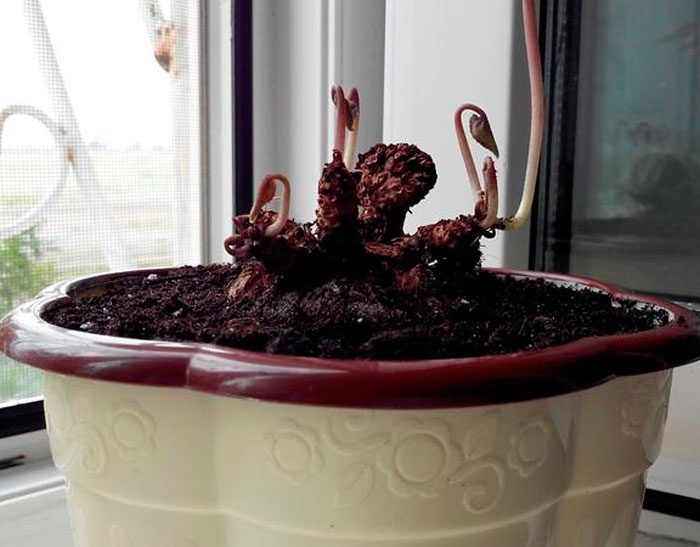
As soon as the foliage begins to dry out and die off the flower, this indicates that a period of dormancy begins. Reduce the frequency, as well as the abundance of watering, and this should be done gradually. And when the plant is completely bare, it is watered sparsely and infrequently.
The room where the plant is located is systematically ventilated. If possible, transfer it to a balcony that is shaded from the sun. In August or September, the bush is transferred to a well-lit place and begins to gradually increase watering. During the dormant period, the flower at home can be stored in another way: when the bush fades, watering is reduced, and when all the foliage dies off, the pot should be turned 90 degrees and in this position it will be stored until the last summer or first autumn weeks ...
Cyclamen transplant
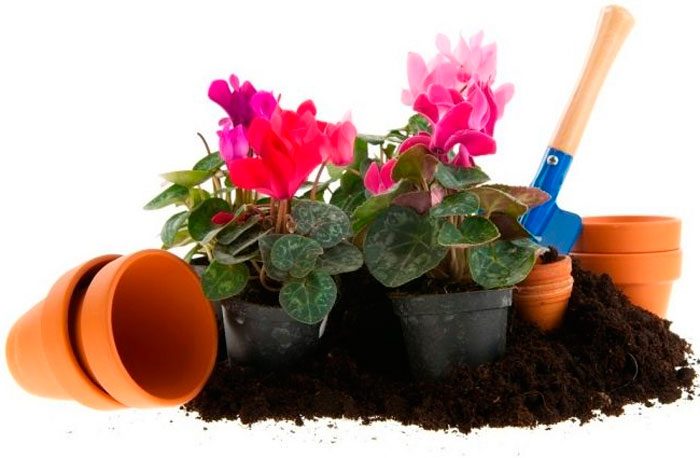
The transplant is carried out annually in August or September, and this is done after the first foliage appears from the tuber. Choose a wide container for transplanting, and fill it with a loose substrate with a pH of 5.5–6. The approximate composition of the soil mixture: humus, sand and peat (one part at a time), and also leafy soil (2 or 3 parts). You can also use a substrate of the following composition: sand, humus and leafy soil (1: 2: 4). If the pH of the soil mixture is higher than 6.5, then the likelihood that the plant will be affected by fungal diseases increases.
After the bush is removed from the pot, cut off all rotten roots, while trying not to injure healthy ones. When planting a tuber, keep in mind that it should rise by half or a third above the soil mixture, thanks to this, the flowering of the cyclamen will be more magnificent. To avoid stagnation of water in the root system, do not forget to make a good drainage layer at the bottom of the container.
Virulence
In the juice of any part of the Persian cyclamen bush, as well as its tuber, there are poisonous substances that can cause diarrhea, convulsions and vomiting.
How is cyclamen useful?
An infusion is prepared from cyclamen, which is used for colic, rheumatism, neuralgia, indigestion and flatulence.
How often to water indoor flowers in autumn
There is a well-known rule that from May to September, house flowers are watered much more abundantly than in the rest of the year. This means that in the fall, watering and spraying of plants is gradually reduced, focusing on the temperature and humidity of the air, as well as on the state of the soil.
There are also some other ways to determine soil moisture. For example, you can take a small handful of earth and knead it in your hands. If it breaks down into small particles, then the soil is dry and it's time to water the plant. Another way is to tap on the bottom of the pot. If the soil is dry, then the sound will be more sonorous than when tapping on a pot of damp earth. You can also check the soil using a moisture indicator, which, however, in the presence of a large amount of mineral salts in the ground, can be mistaken.
Indoor colors in ceramic dishes require much more moisture than others.
What to do with houseplants in autumn
A few important points to keep in mind.
If in spring plants need nitrogen fertilization for growth, then in the second half of summer and early autumn they need phosphorus-potassium fertilizers - to strengthen the root system, resistance to temperature changes and various diseases. Therefore, combine watering with top dressing, focusing on the instructions for a particular fertilizer.
Lighting
In nature, this plant prefers to grow in open spaces, due to which it receives a large amount of light. That is why it is necessary to choose a window in the apartment that will face the south-west or south side. Thus, the place for keeping the culture should be well lit throughout the day. At the same time, you do not need to block the window with tulle or a curtain, since the sun's rays do no harm to either the flowers or the leaves of the Kalanchoe.
There is another secret, thanks to which you can achieve the earliest possible setting of buds from the plant. As a short day crop, it prepares to bloom under approximately 10-12 hours of light per day. If you isolate the Kalanchoe for 1 month from the sun for the rest of the time, you can wait for the formation of buds.

Frequently asked questions
Perhaps the flower has approached the dormant period. It is necessary to gradually reduce watering. Withered cut leaves and peduncles... Remove the flower pot in a cool place.
This happens to a newly purchased flower that seemed healthy. Affected by the change in conditions of detention
Pay attention to air temperature, light and water for irrigation. An east or west window is suitable for life. Perhaps the flower was attacked by pests or diseases
Carry out the appropriate processing
Perhaps the flower was attacked by pests or diseases. Carry out the appropriate processing.
The reason is pests, spider mites or cyclamen mites. They reproduce due to the dry, hot air. Cyclamen is treated with an insecticide solution, the temperature of the content is reduced, the air around the plant is humidified.
This is a fungal infection. The plant needs to be rescued urgently. Removal of dead parts, disinfection in a fungicide solution, drying, transplanting cyclamen into another pot and new soil will help.
That is unnecessary. The flower will decide for itself when it is time to rest.
The air temperature has risen. Place the flower pot closer to the glass, where the temperature is lower than in the room. A saucer of water next to it on the windowsill and spraying the air around will help humidify the air.
This is wet rot. You will have to part with the plant. There is no cure for this situation.
General rules for watering cyclamen
This flower tolerates drought more easily than overfilling. From excess moisture, cyclamen can "pick up" rot.
Try not to get water on the leaves of the cyclamen. Moreover: the green capricious loves humid air, but will not tolerate spraying. How to be? If you do not have a household humidifier, spray the air near the bush, but so that the spray does not fall on it.

If, during planting, the soil is saturated with perlite and / or vermiculite, you can water the cyclamen a little less often.
You overflow the flower if its leaves lose their turgor or wither or die. The plant can still be saved if you immediately get it out of the ground, remove the old soil (rinse it under the shower or gently rinse the roots in a basin), treat the roots with a fungicide, put the bush on the table for a couple of hours to dry. Then the cyclamen is planted in dry soil. In this case, you should take a new pot, but you can sterilize the old one. Don't water it for a while.
Watering methods that work for this flower
Along the edge of the pot. Cyclamen is a capricious plant that cannot withstand the ingress of water on leaves or flowers. Therefore, get a watering can with a long nose (the mother-in-law generally uses an enema, she bought it at the pharmacy especially for flowers). With its help, water should be directed into the ground along the inner wall of the pot. This water will pass through the soil, then through the drain at the bottom of the pot, and pour into the sump. Let her stay there for about an hour, after which everything that the flower has not drunk, drain.
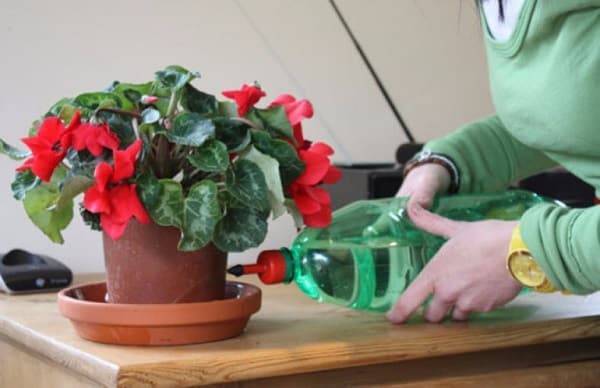
Bottom (in the pallet). It's even simpler: water is poured into the pan, and if after an hour there is something left here, drain it.

Submersible (I call it "in a basin"). Orchids are watered in a similar way. A basin or other container of water is collected (settled, of course).A pot is placed in it so that the leaves do not get wet, but through the holes in the bottom the soil is saturated with water. Take out the pot, put it in another (empty) bowl, in a bathtub or sink, leaving it here for 5 minutes until the excess water drains.
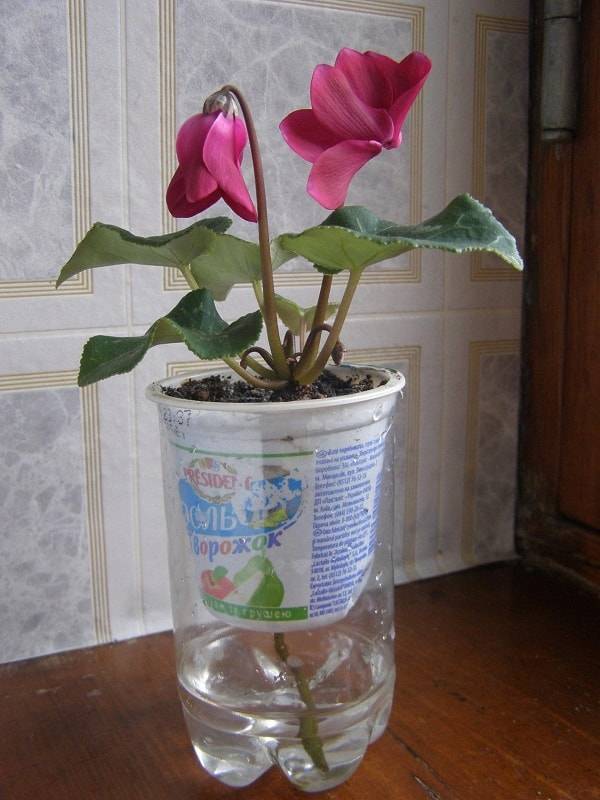
Wick. When planting in a pot, you can lay a thick thread, the end of which will hang from the drainage hole of the pot. Place the pot on a wide tray filled with expanded clay, moss, coconut substrate, peat, large (including marine) pebbles, and shells. Water them from time to time, and the water will flow through the wick into the pot.
What kind of water is used anyway
Settled (from 1 to 2 days in an open vessel - so chlorine will freely leave it), clean, soft.
Of course, if you live in a village and you have your own well, there is no need to defend such water. But it is worth holding it in the room so that it warms up, or hold it a little on the stove - the flowerpot does not like ice watering.

